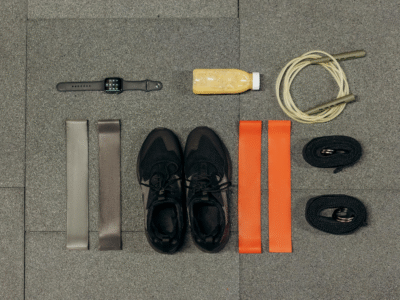Struggling to achieve your fitness goals? Experts and trainers point to hybrid training — the new fitness phenomenon — as being the key to heightened performance and results.
For many gym-goers, the practice of hybrid training is a new — and possibly foreign — concept. When it comes to working out, we all tend to have our preferred means, whether that be outdoor runs, spin classes, boxing, Pilates or weight training. Consequently, varied strengths and weaknesses inevitably occur.
The avid weightlifter may not be able to run very far, for very long. Or the frequent spinner may struggle to get through a weighted arm workout. For me, long-distance runs are something of a long-distance dream.
While this is completely fine, experts have come out with a new fitness trend, labelled hybrid training, and it’s said to be the one of the only means of becoming an all-round athlete, as well as being the key to achieving your fitness goals. But if you’re anything like me, you’re likely to be wondering how to modify your routine to adopt hybrid training and unsure of what the real benefits are. I spoke to some pros to find out.
Read more: How to start running and what you’ll need

What is hybrid training?
“Hybrid training is a combination of strength training and endurance work,” explains Kris King, ultra runner and director of Beyond the Ultimate.
“Traditionally, these two forms of training were seen as being counterproductive to each other. However, with a correct approach, you can become proficient at both, aiming to achieve a balanced skill set rather than specialising exclusively in either strength or endurance.”
So, the concept involves using multiple disciplines, such as running, weight training and Pilates, to create a more well-rounded workout, rather than just focusing on your favourite form of exercise, or the exercise that you think has the most ‘benefits’.
If you’re an avid weightlifter, you may be thinking that incorporating more cardio into your regime or booking in a low-impact mat Pilates class once a week may be a waste of your time, or perhaps will even act as a barrier to you achieving your goals. But according to our experts, it can be highly rewarding for any type of fitness goal.
What are the benefits of hybrid training?
“The key benefit of hybrid training is that it provides a well-rounded athletic profile, turning athletes into versatile performers,” explains Kris. “Mixing up your training can help to build both strength and endurance, which in turn can help improve cardiovascular health.”
It can also be beneficial in reducing your risk of injury. If you only stick to one discipline, you’re more likely to overwork the muscles in that area. With hybrid training, you’ll develop a schedule that forces you to focus on different exercises throughout your week.
If you keep up with current fitness trends, you’re likely to have heard of HYROX by now, the fitness competition that’s taken the UK by storm. Thousands of fitness fanatics have signed up to take part over recent years, and Kris says that the interest is due to hybrid training fostering a sense of camaraderie.
“There’s a strong community aspect that comes with hybrid training. It can be done both in a gym and outdoors, which is why sports like CrossFit and HYROX have seen significant growth, as they attract people who enjoy training together and sharing a variety of workouts.”
There’s also an argument that hybrid training can be beneficial for your mental health. “It keeps things fresh and helps you avoid hitting a plateau because you’re constantly introducing new challenges,” says Obi Vincent, C4 Energy and pliability athlete.
“One of the biggest perks is that it keeps your training exciting. You’re not stuck doing the same routine over and over, which can lead to mental burnout.”
Are there any disadvantages of hybrid training?
Here, Kris says that the phrase ‘Jack of all trades, master of none’ comes to mind.
“One of the main disadvantages of hybrid training is that, if not managed correctly, athletes can impact specific training goals across either strength or endurance, rather than excelling in one. This lack of specialisation means hybrid athletes might not reach the top levels in either area.”
To prevent against this, it’s important to use hybrid training strategically. For example, if you’re interested in taking up a marathon, you should be using hybrid training to help you excel at that goal, like training glutes, core and hamstrings.
Obi adds that hybrid training can be more time-consuming. “It requires careful planning to ensure both strength and endurance can be fitted into your schedule,” he explains.
Read more: Do we really need to be taking creatine to gain muscle?

How can I incorporate a hybrid routine into my workout schedule?
In terms of first steps, think about integrating both cardio and strength training into your routine. Kris notes that a lot of runners tend to think that strength training will negatively impact their endurance, but he labels this as a misconception.
“To significantly alter body composition (e.g., adding muscle mass), athletes would need to adopt a calorie surplus and reduce endurance work — something most runners don’t do. Instead, choosing gyms that cater to hybrid athletes, such as those offering CrossFit or HYROX-style workouts, can naturally introduce hybrid elements.”
If you’re not into those types of competitions, you can work with specialised hybrid training platforms or coaches in your gym to develop a personalised routine. Alternatively, Obi points to circuit training as a great way to work both types of exercise into your week.
“Circuit training combines cardio and weights, so it’s a time-efficient way to work both in. Just make sure you schedule enough rest to avoid burnout, and adjust the routine based on your personal goals and how well you’re recovering.”
Adding cardio into your routine a couple of times a week, booking a different type of class or lifting some light weights in between run days can all help to create a formidable schedule — and a versatile athlete.













